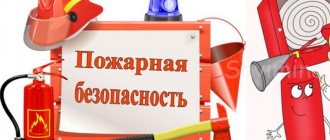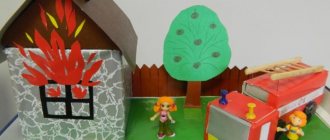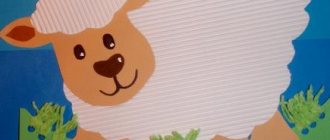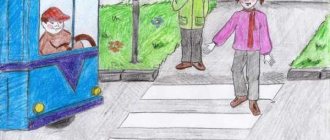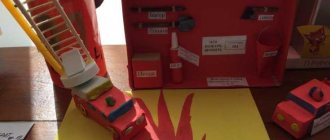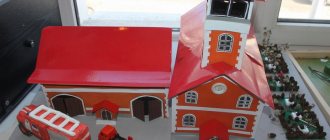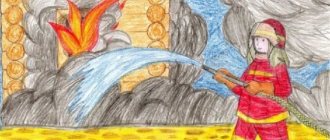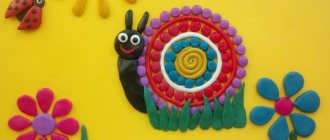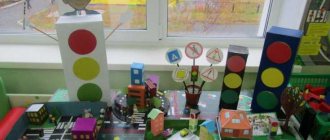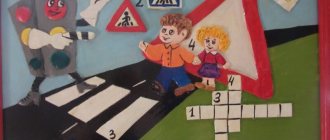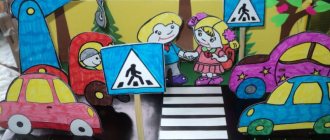It is useful for every child to know the basics of fire safety, but the child may still be too young for special classes. Simple and unusual crafts on the topic of fire safety for school and kindergarten will help diversify the process of learning necessary and important information.
Drawings and applications, three-dimensional installations can decorate a child’s room or become exhibits at a school exhibition. It’s good if there is a firefighter in the family or among friends and he can answer the children’s curious questions, and the creative process itself can be realized together with the child.
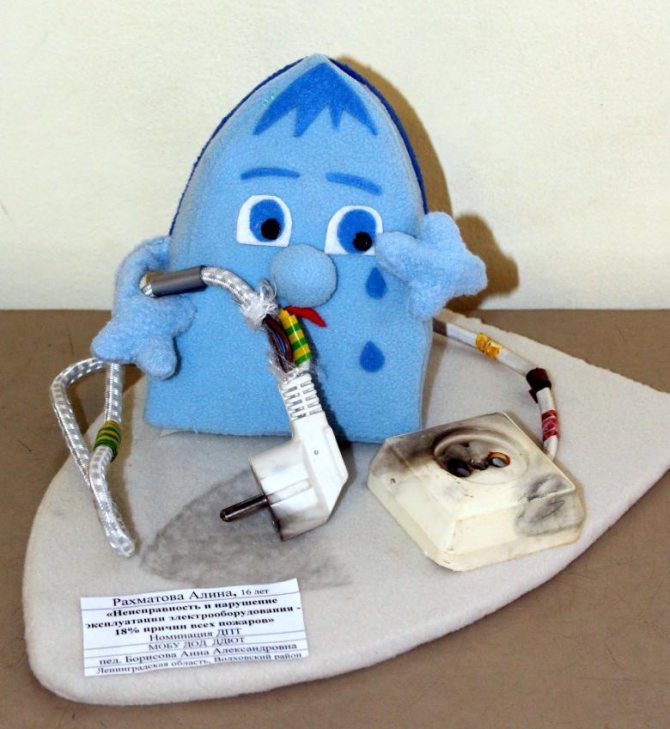
Creative approach to learning
Unfortunately, not all kids will listen to you if you just lecture them. Uninteresting information quickly disappears from their heads. Therefore, you need to take it using other methods.
And one of these methods is creating crafts with your own hands on the topic of fire safety, road safety, water safety, and more. This will obviously attract a lot more attention and force them to absorb at least some useful knowledge.
Subject Features
Every educational institution pays great attention to fire topics, and the task of parents is to promote such upbringing of the child at home. When making crafts, children gain certain labor skills and develop fine motor skills; they become familiar with fire safety rules and the difficulties of working in the Ministry of Emergency Situations.
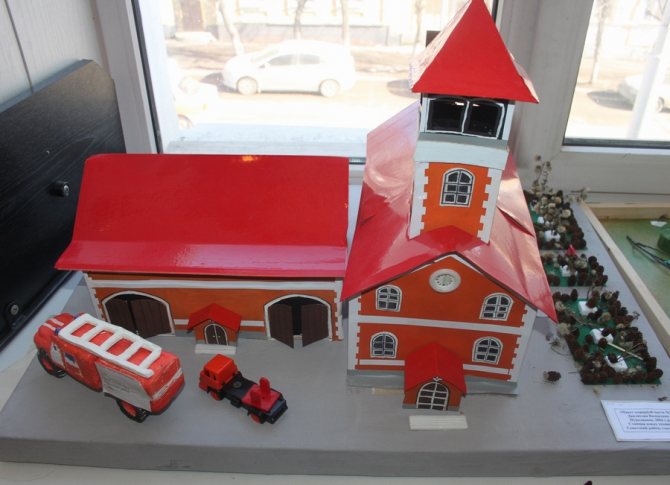
Crafts can be taken to kindergarten or school, submitted to a competition, or simply used as a toy.
In the works on the topic under consideration, the following main plots stand out:
- What causes a fire and how dangerous it is. You can reflect the following directions: “Matches are not a toy”, “Be careful with fire”, “Do not light a fire in nature”, “From a spark begins a flame”, etc.
- Actions in case of fire. Of particular interest are fire extinguishing means and equipment. A bright fire truck is a popular craft. By making a fire shield, the child gets acquainted with the basic methods of fighting a fire.
Children's crafts can be created from different materials depending on the age and skills of the child. It is important to start with simple things, gradually moving on to more complex products.
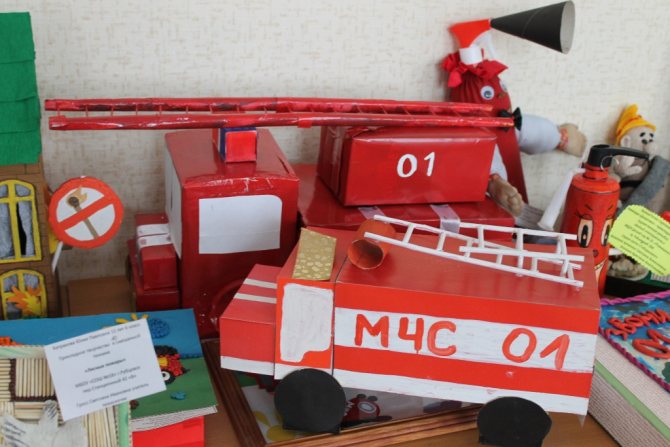
Explaining to a child the rules of handling fire using crafts
Reinforcing fire safety information through crafts is the most effective way for children to remember fire safety rules. Topics for crafts can be different, depending on what needs to be consolidated in the child’s mind:
- fire situations;
- child's behavior in case of fire;
- fire hazardous items;
- firefighter profession;
- how to put out a fire.
Note! These are the basic ideas for crafts that a child can do with his own hands. Depending on the age and level of training of the child, you can choose the type of applied art.
Rescue of a drowning man
With the help of crafts on the topic of water safety, you can protect your child from the possibility of drowning when swimming in a river or lake due to wrong actions. Most little children love the cartoon “Smeshariki”. So find out from your child about his favorite heroes and bring to life the idea of saving a drowning person.
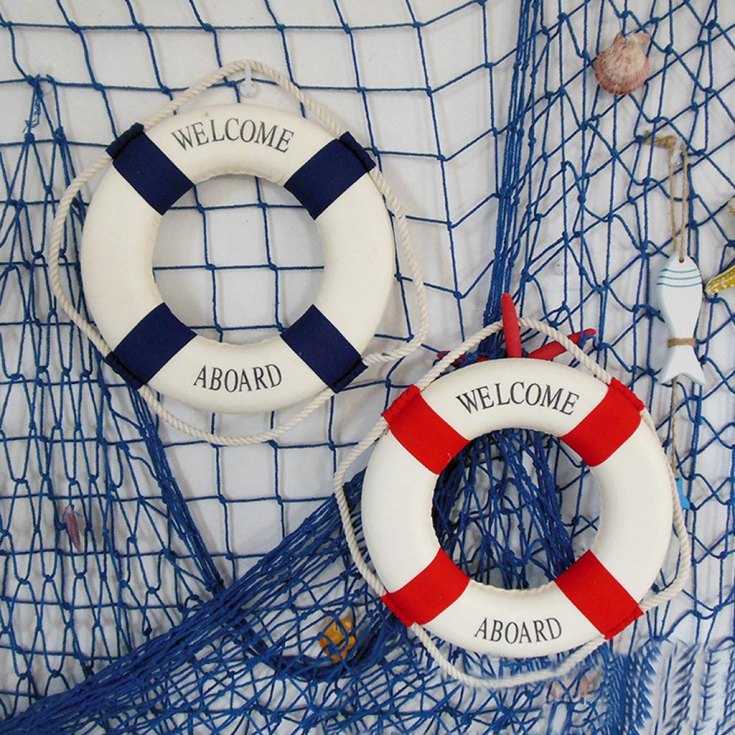
Let’s say, if a child loves a pig and a rabbit, then let her swim too far, and he decides to save her with the help of a lifebuoy. All this can be played out by using materials such as plasticine.
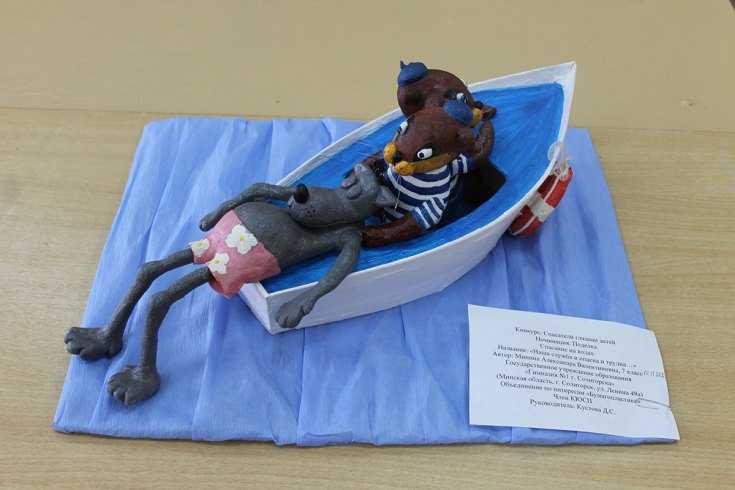
After the work is finished, and the baby learns that he can’t swim too far and needs to stay close to adults, he can just play with his favorite characters.
Applications and drawings on paper
In most crafts, a paper or cardboard base is used as a base on which other materials are applied. This technique is suitable for small and older children due to its ease of implementation, and at the same time the child learns concepts such as general and particular, and masters techniques for processing various materials.
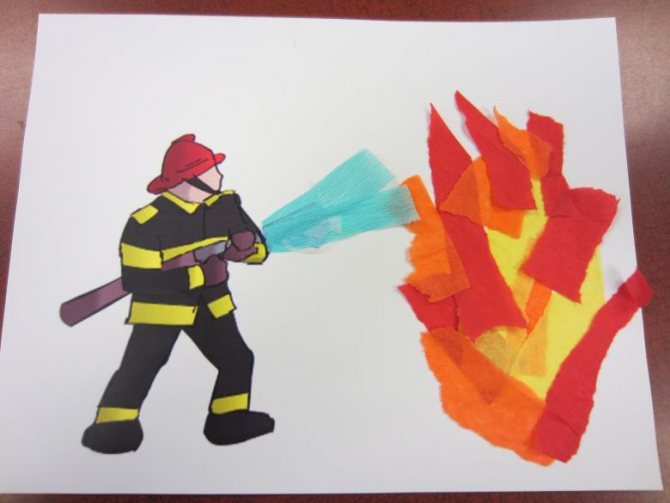
Bulk craft
For the little ones, you can draw a simple drawing and divide it into zones into which bulk material needs to be placed. The most commonly used are semolina, buckwheat and rice, legumes and peas, collected seeds and seeds of various plants, you can use crowded balls of napkins.
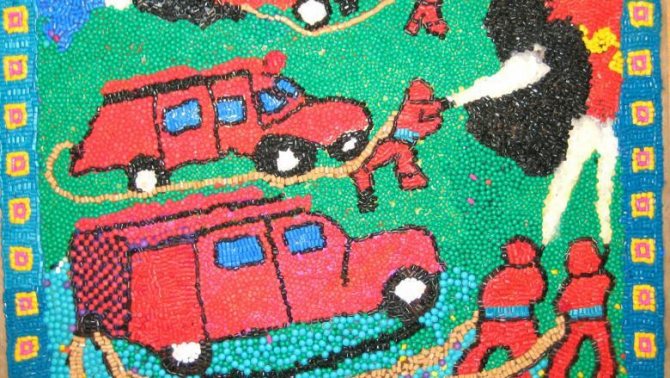
From colored paper
The simplest applique, which will be complemented by a drawing, is made up of paper elements; paper can be replaced with fabric. The theme of the colored paper applique should be plot-driven and tell a specific story that will tell children how to act in a dangerous situation.
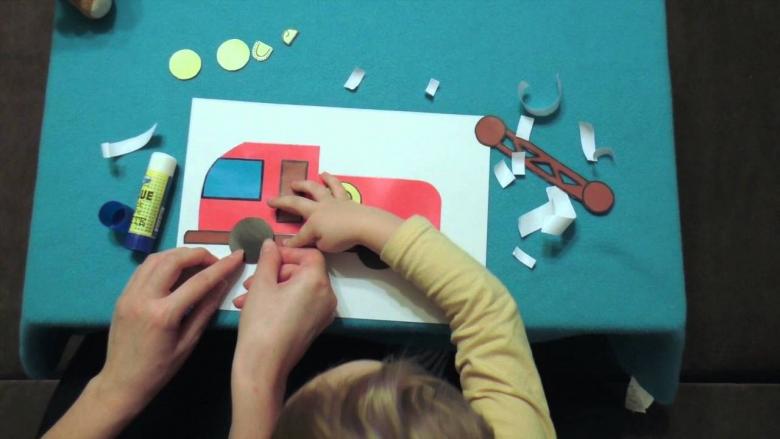
Crafts for kindergarten
Every year in kindergarten there is a competition for making crafts on the topic of safe behavior in various dangerous or unfavorable conditions.
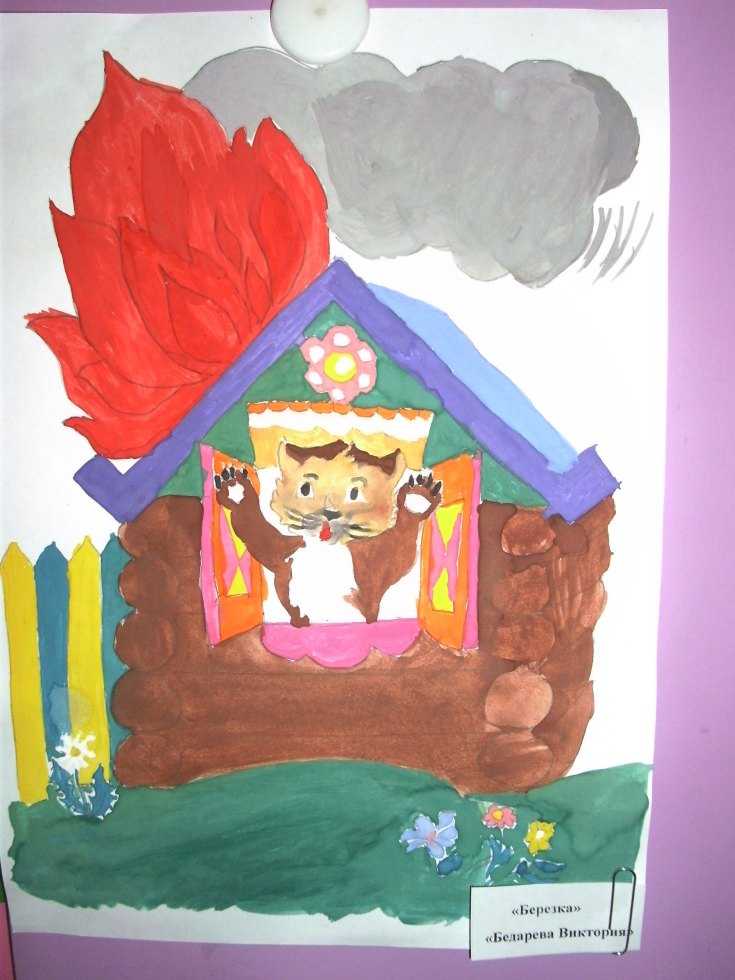
If a child does not want to do anything creative and learn the rules, then let him know that if he can create something truly unusual and beautiful, he will receive a gift.
And also his work will be kept on a public stand and both children and adults will clearly appreciate and admire his talent. Such words will light up the eyes of any person, and he will undoubtedly take up this matter.
Interesting and Easy Craft Projects
If you receive an assignment in kindergarten or school that involves making crafts on the topic of fire safety, you should not give up. Such products can be made with different designs, taking as a basis a certain plot that the child will like and this will help attract him to work.
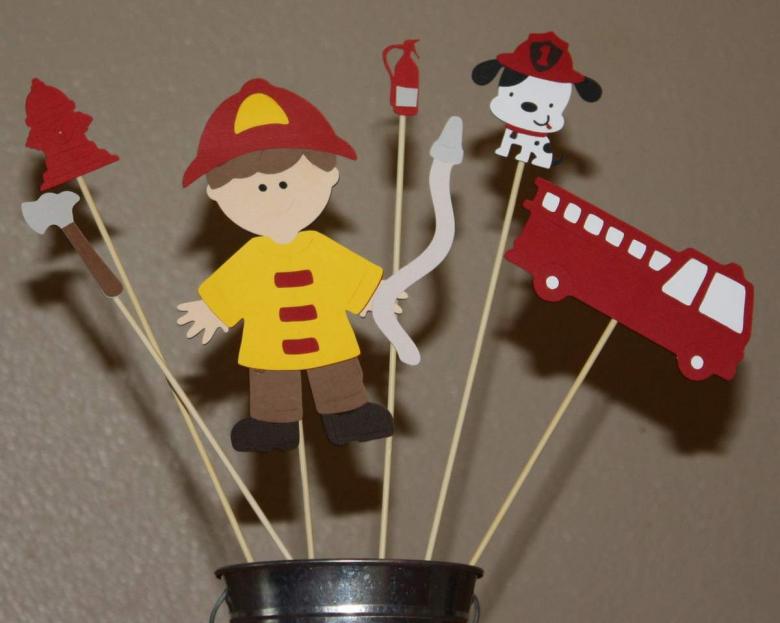
Knowing the child’s age, you can choose the best idea and the creative process will certainly captivate the child, and along the way, you can explain fire safety rules to him. Under the careful guidance of their parents, children will be able to make three-dimensional crafts from paper and plasticine, draw a picture or glue an applique.
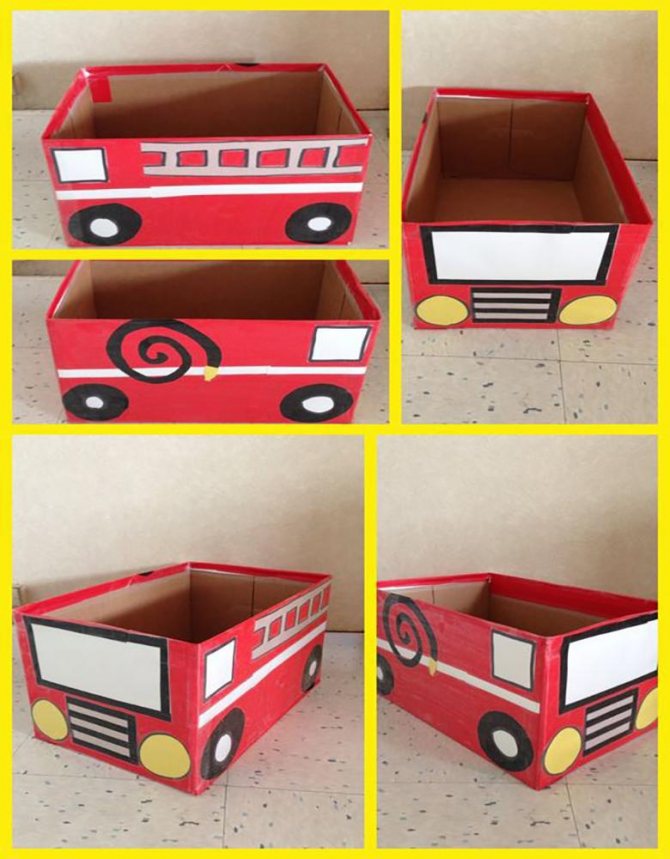
When considering many ideas, it is important to focus on the age limit and take into account what techniques the child already knows. Any work will differ in complexity and the number of elements used, the difficulty of assembly and the amount of time spent on the creative process.
Volumetric products
Three-dimensional crafts that are designed to draw attention to the problem of fire safety look as clearly as possible. This could be a mock room created in a cardboard box, a large fire truck made of bright red cardboard, or a burning house with paper flames.
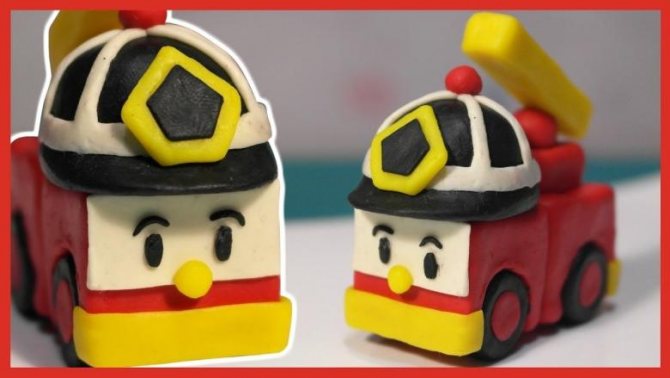
When creating installations, you should not use scenes that frighten children, which can negatively affect their psycho-emotional state. The child must understand that in case of a fire it is important to act according to plan and always seek help, which is reflected in crafts and finished installations.
Paper crafts
For young children who are just getting acquainted with paper processing techniques, it is better to use simple and accessible ideas. You can make a bright fire truck from colored sheets; for this, a rectangular box is covered with paper, and hoses from cocktail tubes are glued to the roof.
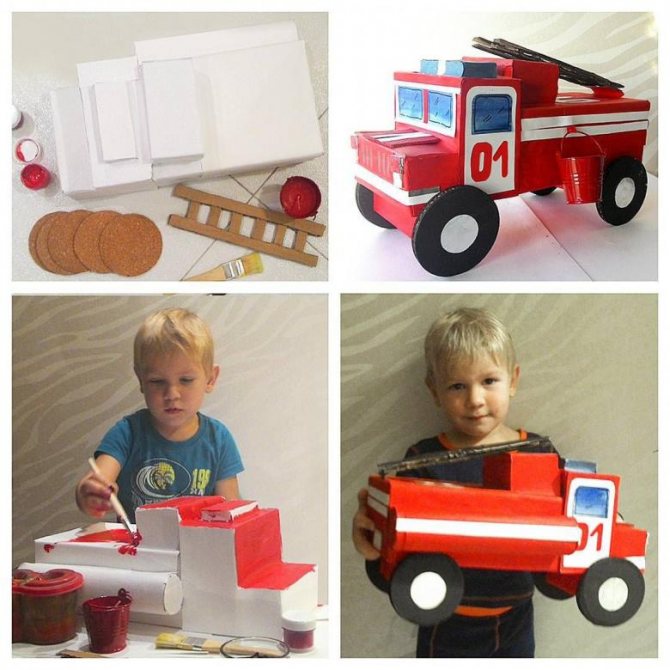
Cardboard rolled into a tube with glued bases will turn a boring figure into a cheerful fire extinguisher. Such an interesting assistant will help the child understand how to behave in an unforeseen situation and what to look for in the room, and will ensure an expansion of the vocabulary used.
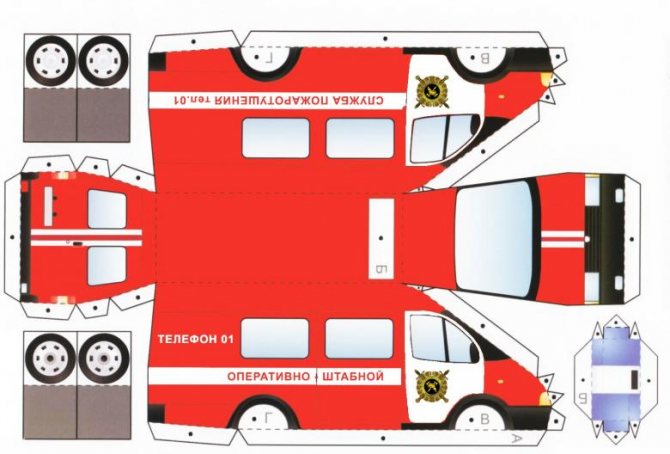
Salt dough modeling
Children love to play with Lego, but not all figures are suitable for making crafts, but you can make them yourself from salt dough. After complete drying, the figures will not blur for a long time, will retain the desired shape and can be painted in bright colors using paints.
The soft and pliable dough can be used to sculpt individual figurines of firefighters and a house, a fire truck and the inhabitants of the house. You can also glue ready-made figures to a cardboard base and create an original and very unusual picture or three-dimensional applique from lightweight materials.
Ordinary plasticine can replace salt dough, but applications using it will not retain their visual appeal for long. An applique coated with airy plasticine will look original and can be used to easily make crafts with a large number of small details.
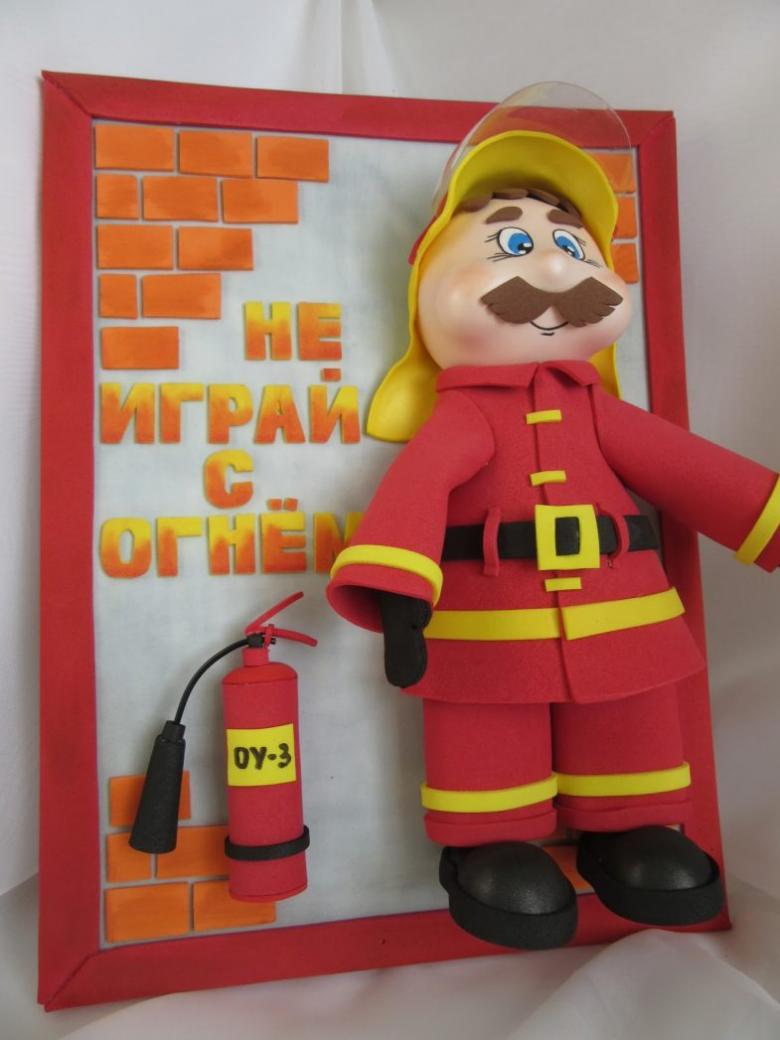
Craft for school
The school is also an institution that is responsible for the safety of the children there.
And the main task of teachers is precisely to teach useful lessons to students and protect them from various disasters and regularly occurring crimes. Therefore, they also hold competitions and exhibitions of similar children's products. And they also encourage talented students for their efforts and diligence when working on such a significant project.
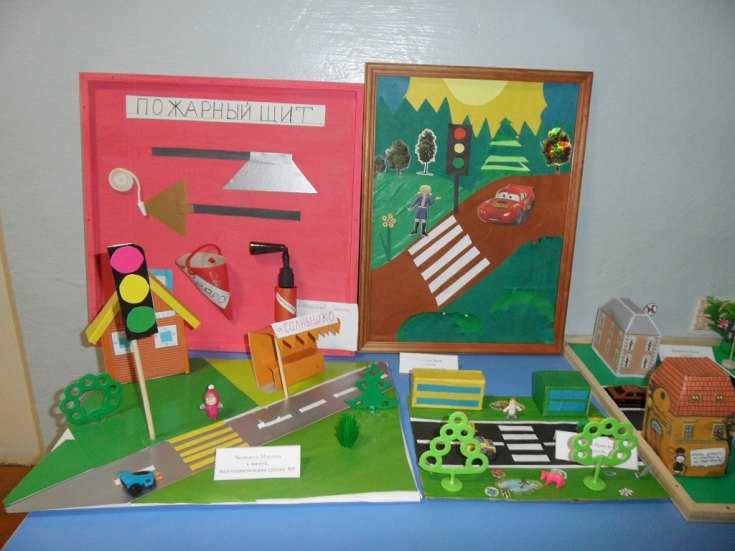
In connection with the expansion of the child’s knowledge about such properties of objects as shape, structure, size, and their spatial arrangement on paper, application tasks become more complicated. This concerns the design of objects, solving more complex compositional and coloristic problems in the design of works. The teacher teaches children to more accurately cut and paste simple shapes, based on a square, rectangle, or triangle. They can be used when composing ornamental compositions to decorate a scarf, plate, rug, path, and also display objects such as cubes, scarves, scarves, etc. Then the children are taught to cut out individual parts and assemble more complex objects from them (house, birdhouse, gate), and also combine them with each other in size (the house is large, and next to it is a gate, they are lower than the house).
In applications, children should be able to combine compositions by color, by methods of spatial arrangement on the surface of a sheet of paper of a certain format, which makes it possible to perform tasks of a different nature (subject, thematic and ornamental), differentiate specific tasks for each of them in the process of thinking about the future image, its cutting and pasting.
Before teaching preschoolers how to cut with scissors, it is necessary to strengthen their ability to lay out and paste ready-made shapes using the example of creating patterns from geometric or plant elements (one or two lessons at the beginning of the school year). So, you can invite the children to decorate a scarf or an apron for a doll with patterns, giving them the opportunity to independently choose a blank according to shape, color, select elements for decoration, and arrange them in their own way by color and location. If the baby has chosen a white square to decorate it in the form of a scarf, then he can take small colored squares and place them in the corners of the main workpiece. Alternating red and blue shapes will look good between the squares. When a child takes a stripe - a red scarf - for decoration, the teacher helps him rhythmically repeat the squares placed on the corner along the entire length, combining green and yellow tones (white and black; black and green).
To make such a choice, you must have in advance options for blanks and individual elements of different colors and sizes to compare them when creating an ornament. The teacher helps children in choosing a background, a pattern, varying figures in number, shape, color, and rhythm. The figure shows options for applications of varying degrees of difficulty. Children independently combine squares of various sizes and colors, as well as triangles and circles, based on the proposed motives.
Decoration with patterns of scarves, scarves, plates
At the beginning of the lesson, the teacher gives verbal instructions. For example, if a child has chosen a scarf (square base) for the exercise, then he is asked to use a combination of large and small elements (squares of a different color) or complement the pattern with triangles. To decorate a scarf (triangle), it is better to take circles and attach triangles between them. And children can decorate round plates and trays with an ornament of small circles, alternating them by color, or build another patterned composition from them.
When children master the techniques of laying out and gluing forms, their attention is focused on the techniques of using scissors when cutting out elements for appliqué. This process requires significant effort, attention and will. To make it easier, the teacher initially trains the child in cutting narrow strips across with uniform movements of scissors, performing a game task: cutting out tickets for playing “theater”, “circus”, checks for playing “shop”, coupons for playing “hospital”, travel tickets for playing “bus”, etc. The game form of cutting results increases the child’s interest in this process; in a relaxed play environment, he more easily learns how to use a new tool, adapts his movements to learn how to operate scissors. Children should definitely be given well-designed scissors so that their arms move easily and do not create additional difficulties.
The teacher observes the work of each child, provides him with timely assistance, encourages his efforts, supports the desire to learn how to correctly, beautifully cut out shapes (so that their contours are smooth and not frayed).
As an exercise for the hands, it is necessary to give the children tasks that require the completion of several identical cuttings. In this case, the movements are consolidated and improved. For this purpose, you can use ornamental structures, as well as object images consisting of several homogeneous parts. For example, when cutting out windows of a two- or three-story house, take a strip of paper of a certain length and width and cut it crosswise into several parts at an equal distance from each other. They are glued onto a rectangle, observing the rhythm of the arrangement: at designated intervals in one, two or three rows (corresponding to the number of floors of the house).
In the same way, appliqués are made for bus or trolleybus windows, as well as for a festive garland of flags. Here you need to alternate the shapes by color and create a bright sound for the decoration. Therefore, the teacher prepares multi-colored stripes in advance, and the children choose the brightest ones that they like and learn to alternate them when gluing them onto a background like a garland or on a stand using flagpoles of different heights, or on sticks, etc. The possibility of interpreting the content of the application is emphasized when the wording of the task: “Holiday flags”, “The flags that we saw in the square”, “A festive garland of multi-colored flags”.
Different types of flags
In subsequent appliqué classes, children are taught to cut out a rectangular shape more accurately and differentiate between a rectangle, a square, and a strip. The basis for cutting out these shapes is a strip of paper of different lengths and widths. Thus, a rectangle is obtained by cutting a strip of 3x12 cm into two parts, and dividing each of them in half again allows you to get two squares, which are then glued to decorate the end of a towel or scarf.
You can change the size of the elements or give them different positions, for example, place large and small squares placed on the corner in a row, alternating them also by color (red and green figures on a white towel background; blue and orange; red and yellow). This task requires the child to comply with the following conditions: cut out several identical shapes, independently adjust their number depending on the construction of the pattern, combine elements by size and color. Providing independence in choosing the background color and blanks for parts of the decoration allows children to take a creative approach to creating an ornament and use different options for its interpretation.
To consolidate the ability to depict squares and make various combinations out of them, appliqués are grouped from individual parts like a mosaic. Each child is given multi-colored strips of the same size, from which he receives squares, and combines them in the form of patterns or object images on backgrounds of different shapes and colors. Children complete such mosaics independently in their free time. To do this, a separate corner is organized in the group room - an area where the materials necessary for work are placed. Their color and diversity encourage the child to create a panel for a doll’s corner, decorate an apron or dress with a pattern, prepare a greeting card for a holiday, etc.
Mosaic applique of multi-colored squares
From a square, by cutting it in half diagonally with a continuous movement of scissors, two triangles are obtained. Typically, children learn this technique quite easily and quickly. But, despite this, it must be reinforced in several lessons, maintaining the preschooler’s interest in the image process and its result. This is achieved by selecting interesting tasks: “Kerchiefs for nesting dolls”, “Huts in the forest”, “Christmas tree”.
Along with homogeneous parts, combinations of rectangular, square, and triangular shapes are also used in applications. This is how fish are cut out and pasted, combining a square (body) placed on a corner and a triangle (tail) or two triangles - a large one and a smaller one. To achieve greater resemblance to the image of a fish, additionally glue on large eyes, stripes or scales of colored paper. You can make an especially elegant applique on the theme “Aquarium”, where on a blue or blue plane children place large and small fish with a triangular or square body in yellow, red, orange, gray in combination with green algae, pebbles at the bottom, etc. To obtain such a composition, the teacher prepares a background with pasted silhouettes of algae, stones, shells, and the children glue fish of different colors and sizes between them. Here, each child can show his creative activity: change the direction of movement of the fish in his own way, make them larger, smaller, use decorative stickers (stripes, circles-scales).
Techniques for cutting triangles and fish variants from squares and triangles
Fishes in an aquarium
Photos of crafts on the theme of safety
0
